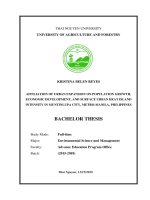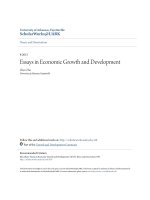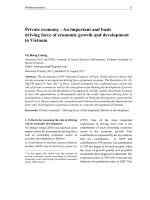Economic growth and economic development 645
Bạn đang xem bản rút gọn của tài liệu. Xem và tải ngay bản đầy đủ của tài liệu tại đây (95.49 KB, 1 trang )
Introduction to Modern Economic Growth
where ρ > 0 is the discount rate and C (t) is consumption at date t.
Let Y (t) be the total production of the final good at time t. We assume that
the economy is closed and the final good is used only for consumption (i.e., there is
no investment or spending on machines), so that C (t) = Y (t). The standard Euler
equation from (14.31) then implies that
(14.32)
g (t) ≡
Y˙ (t)
C˙ (t)
=
= r (t) − ρ,
C (t)
Y (t)
where this equation defines g (t) as the growth rate of consumption and thus output,
and r (t) is the interest rate at date t.
The final good Y is produced using a continuum 1 of intermediate goods according to the Cobb-Douglas production function
Z 1
ln y (ν, t) dν,
(14.33)
ln Y (t) =
0
where y (ν, t) is the output of νth intermediate at time t. Throughout, we take the
price of the final good (or the ideal price index of the intermediates) as the numeraire
and denote the price of intermediate ν at time t by χ (ν, t). We also assume that there
is free entry into the final good production sector. These assumptions, together with
the Cobb-Douglas production function (14.33), imply that each final good producer
will have the following demand for intermediates
(14.34)
y (ν, t) =
Y (t)
, for all ν ∈ [0, 1] .
χ (ν, t)
Each intermediate ν ∈ [0, 1] comes in two different varieties, each produced by
one of two infinitely-lived firms. We assume that these two varieties are perfect
substitutes and compete a la Bertrand. No other firm is able to produce in this
industry. Firm i = 1 or 2 in industry ν has the following technology
(14.35)
y (ν, t) = qi (ν, t) li (ν, t)
where li (ν, t) is the employment level of the firm and qi (ν, t) is its level of technology
at time t. The only difference between two firms is their technology, which will be
determined endogenously. As in the models studied so far, each consumer in the
economy holds a balanced portfolio of the shares of all firms. Consequently, the
objective function of each firm is to maximize expected profits.
631









